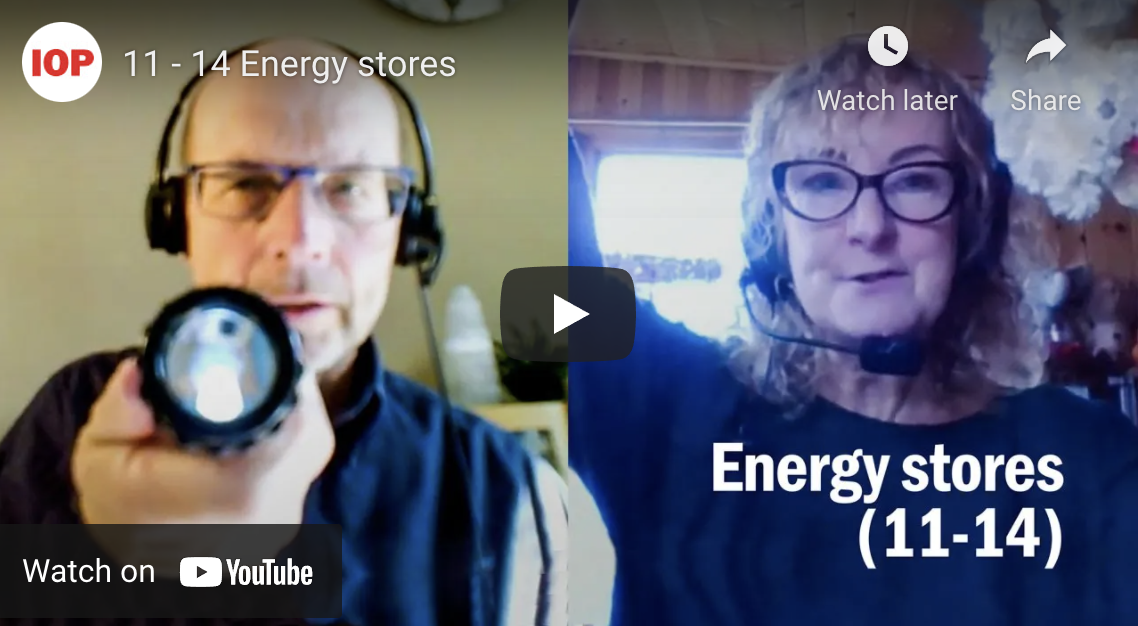1 – Introduction: how high? how fast?
![]() Allow about 10 mins
Allow about 10 mins
This section can be studied at home or school. In total it should take up to 1.5 hours.
Course requirements
As part of the blended course, this topic is designed to be studied after first doing the face-to-face session Ener1 – Energy Stores and models.
If you missed this face-to-face session, you could catch up on some of the missed ideas by watching the following videos from the IOP domains series:
Energy stores - part of the IOP Domains CPD programme
Choosing start and end points - part of the IOP Domains CPD programme
Overview
In the face-to-face sessions we have examined the names of energy stores, and some methods that can be used to help teach the following key messages:
- The amount of energy in a store is calculable.
- The total energy in a system is always conserved.
- Knowing the values of energy stores may tell us whether an action can happen (but not why it happens, or if it will happen).
- If we compare the amounts of energy in stores before and after an event, then we can calculate efficiencies.
- Calculating the energy values as one store empties and another fills enables us to make quantitative predictions about physical changes, such as changes to temperature and speed.
This final point leads to the sort of questions that we can expect students to ask and then be able to answer using an understanding of energy: ‘How high? How hot? How stretched? How fast?’. In this section will look at how this discussion can be embedded in your question, and then examine where the equations come from that enable us to make these quantitative predictions.
 There are five
different energy stores that we are likely to associate with KS3: chemical,
thermal, kinetic, gravitational and elastic. As students grow in confidence
students are likely to also discuss nuclear, electric-magnetic and possibly
vibrational energy stores. Students probably will not notice, but as you dig
deeper you may spot that there is overlap between some of the energy stores,
and at a microscopic level we can see that some of them are caused by the same underlying
processes! One example that chemical, elastic and some vibrational stores all
contain a component that is caused by the attraction between electric charges.
If this is the case, we can ask the question, “why do we need so many stores?”. The answer for once is surprisingly simple:
it makes much more sense at a macroscopic level, and by choosing these stores
sensibly we can use well-defined equations to quantify systems.
There are five
different energy stores that we are likely to associate with KS3: chemical,
thermal, kinetic, gravitational and elastic. As students grow in confidence
students are likely to also discuss nuclear, electric-magnetic and possibly
vibrational energy stores. Students probably will not notice, but as you dig
deeper you may spot that there is overlap between some of the energy stores,
and at a microscopic level we can see that some of them are caused by the same underlying
processes! One example that chemical, elastic and some vibrational stores all
contain a component that is caused by the attraction between electric charges.
If this is the case, we can ask the question, “why do we need so many stores?”. The answer for once is surprisingly simple:
it makes much more sense at a macroscopic level, and by choosing these stores
sensibly we can use well-defined equations to quantify systems.
Although this topic is called just ‘energy’ and a lot of time is spent talking about the amount of energy in a store, it is intimately linked with the idea of ‘power’. There are many situations when comparing the amount of energy in stores is the most logical way to examine a problem: for example, knowing how high a stretched elastic band could ping into the air; or figuring out how many Mars Bars you need to eat to climb Everest.
However, there are also plenty of times that measuring the value of an energy store does not tell us much useful, and it is more illuminating to consider the rate at which these energy stores are filling or emptying – this is the power. Examples where the power of a system is relevant include the studies of electrical appliances, examples can include a motor, sound system, fridge-freezer or light-bulb (this is dealt with in the Electricity and Magnetism module, section 7.2 - Power calculations). Power calculations also prove more relevant in many other areas as well including developing thermally efficient homes and improving performance in sports science (such the power output of a cyclist’s legs, or the power required by a weightlifter).
Undoubtedly some students will conflate energy and power together, and others will not have a clear definition of them, so we should try to treat them as separate quantities, but see the connections between them. We look at one way of clearly delineating the terms force, energy and power that gets students performing some simple physical exercises.
Progression
Key terminology
Energy is a quantity/number that is always conserved in a complete system. It can quantify how much work has been done on an object, or the amount of work that it has the potential to do – therefore giving us an indication of what can happen in that system. Objects can store energy in different ways, and objects can have multiple energy stores at the same time (a flaming arrow possesses energy in a kinetic, gravitational, thermal, and even a chemical store). The SI unit for energy is joules.
Energy stores: these are terms used to describe the amount of energy associated with one property of an object. The amount of energy in a store is measured in joules and are a scaffold for future calculations.
- The energy in an object’s chemical store changes when atoms or molecules combine or break apart. Associated with batteries, food and fuels.
- The energy in an object’s gravitational store changes when its position changes compared to a massive object (e.g., an apple being lifted up on Earth).
- The energy in an object’s thermal store changes when it changes temperature. It can also change as it changes state.
- The energy in an object’s elastic store changes when it is stretched or squashed.
- The energy in an object’s kinetic store changes when it changes speed.
- The energy in an object’s nuclear store changes when nuclei are changing, for example combining or breaking apart.
- The energy in an object’s electric store changes when brought closer or further away from another charged object.
- The energy in an object’s magnetic store changes when brought closer or further away from another magnetic object. Some teachers and schemes of learning combine electric and magnetic stores because they are intrinsically linked together, as explained at university level by Maxwell’s Equations.
- The energy in an object’s vibrational store changes when an object is oscillating about a point. Many teachers and schemes of learning ignore this as a store. One example where it may be useful is when describing a just-plucked guitar string: the string is alternately moving quickly and then stretching many of times a second; energy is constantly shifting between elastic and kinetic stores, it is simpler to describe it as a single vibrational store of energy.
Energy pathways are the physical process by which one energy store empties and another fills. As energy pathways measure a change in energy in a given amount of time, it may be more appropriate to measure some changes using power. The SI unit for power is watts. We will consider the following pathways.
- Electrical working is when a current passes through an object.
- Mechanical working is when a resultant force acts to move an object.
- Heating by particles occurs between two objects which are at different temperatures and touching one another.
- Heating by radiation occurs when an object emits or absorbs an electromagnetic wave (such as infra-red).
Activities
| Task title | Approximate study time (mins) | Outcomes |
|
10 |
Understanding of this topic's content and place in the curriculum. |
|
|
20 |
Why do we study the topic of energy at all? One reason is to answer simple questions such as how high, how fast, how hot and how stretched. How can you incorporate these ideas into your teaching? |
|
|
20 |
How can we clearly separate the terms force, energy and power when discussing mechanical working? |
|
|
10 (optional) |
If you previously taught about eight energy ‘types’ which included sound and light, find out where these went, and why! |
|
|
15 |
What are the next steps you could take to refine your energy language, with the intention of avoiding some student misconceptions? |
|
|
10 |
Test your understanding of energy models. |


